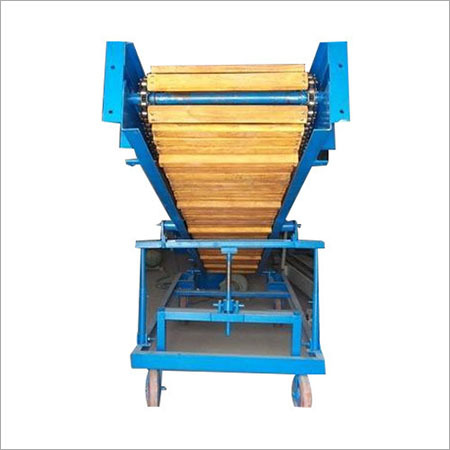Vertical Bucket Conveyor
Price 348000 INR/ Unit
Vertical Bucket Conveyor Specification
- Product Type
- Vertical Bucket Conveyor
- Material
- Stainless Steel
- Type
- Bucket Conveyor
- Load Capacity
- 1 to 3 Tonne
- Voltage
- 400 Volt (v)
- Power
- 3000 Watt (w)
Vertical Bucket Conveyor Trade Information
- Minimum Order Quantity
- 1 Unit
- Supply Ability
- 20 Units Per Month
- Delivery Time
- 1 Week
- Main Domestic Market
- All India
About Vertical Bucket Conveyor
Vertical Bucket Conveyor
A Vertical Bucket Conveyor is an electrically powered machine commonly used in food, beverage, chemical, cement manufacturing, and more to move large volumes of various types of products. The structural frame of this machine is manufactured using top-grade alloyed steel, providing high rigidity and strength to bear extreme material loads and vibrations produced during operation.
It is equipped with an electric motor, making it easier to deliver rotational power at variable speeds. The buckets of this machine are fabricated using top-grade high-density thermoplastic, making them suitable to carry various types of corrosive as well as non-corrosive materials.
Clients can get a Vertical Bucket Conveyor as per their requirements with a minimum order quantity of 1 unit at a reasonable price.
Features of Vertical Bucket Conveyor
-
Capable of holding and carrying various materials in the form of powder, granular, and small solids.
-
Can be used to transfer materials vertically or at an angle.
-
Automated and continuous operation makes it suitable to move large volumes of materials.
-
Rigid and sturdy design ensures it can withstand extremely harsh industrial conditions.
-
Versatile, capable of handling powdered, granular, and pelletized products.
-
Requires minimal maintenance, resulting in high cost efficiency.
Equipped with advanced safety systems, making it suitable for various operational conditions.
Technical Specifications
-
Dimension (LxWxH): Vary from different models
-
Power (W): 3-22 kW
-
Voltage: 220V, 380V, 415V
Form of Lifting: Belt, Chain, or Plate
FAQs: Vertical Bucket Conveyor
How does a vertical bucket conveyor work?
A vertical bucket conveyor is an electrically powered material handling unit designed to transport bulk materials. The working cycle is as follows:
-
Loading materials into the hopper.
-
Buckets fixed to the conveyor belt scoop up the material.
-
Buckets lift the material to the desired level and tilt to pour it out.
-
The cycle continues to ensure continuous movement of materials.
What are the main components of a vertical bucket conveyor?
-
Buckets: Scoop-shaped, designed to collect materials from the inlet hopper. Fixed to the conveyor belt for continuous movement.
-
Belt: Elastic continuous belt used as a transmission element between the drive and driven unit.
-
Motor: Electrically powered drive that delivers power to move the material vertically.
-
Structural Frame: Main support structure made of top-quality alloyed steel, providing rigidity and strength to bear extreme loads and vibrations.
What industries use vertical bucket conveyors?
-
Agriculture: Handling flour, rice, and various food grains.
-
Mining: Transporting ores, coal, minerals, and sand.
-
Food and Beverage: Handling powdered, granular, and pellet raw food products.
-
Chemical Industry: Efficient movement of bulk chemical materials.
-
Waste and Recycling: Transporting shredded waste materials.
What are the advantages of using a vertical bucket conveyor?
-
Efficient transportation of bulk materials.
-
Requires less floor space for installation.
-
Compatible with fragile materials due to gentle handling.
-
Easy-to-change buckets for adjusting material handling capacity.
-
Reduced material wastage.
-
Continuous operation reduces downtime.
-
High cost efficiency.
Can a vertical bucket conveyor handle fragile or delicate materials?
Yes, considering the following:
-
Bucket Design: Gentle and smooth curves to prevent damage.
-
Speed: Low-speed transport for smooth movement.
-
Material Properties: Consider physical and chemical properties for selecting the appropriate bucket.
-
Cleaning: Proper cleaning maintains the integrity of delicate products.
-
Additional Features: Vibration damping and cushioning effects can be installed for extra protection.
FAQs of Vertical Bucket Conveyor:
Q: What is the voltage requirement for the Vertical Bucket Conveyor?
A: The Vertical Bucket Conveyor operates at a voltage of 400 Volt (v).Q: What is the load capacity of the Vertical Bucket Conveyor?
A: The Vertical Bucket Conveyor has a load capacity of 1 to 3 Tonne.Q: What is the power consumption of the Vertical Bucket Conveyor?
A: The Vertical Bucket Conveyor consumes 3000 Watt (w) of power.Q: What material is used to manufacture the Vertical Bucket Conveyor?
A: The Vertical Bucket Conveyor is made from stainless steel.Q: What type of conveyor is the Vertical Bucket Conveyor?
A: The Vertical Bucket Conveyor is a bucket conveyor type.


Price:
- 50
- 100
- 200
- 250
- 500
- 1000+
More Products in Belt Conveyor System Category
Infeed Gravity Belt Conveyor
Price 125000.00 INR / Unit
Minimum Order Quantity : 2 Units
Material : Stainless Steel, Rubber, Plastic
Type : Gravity Conveyor
Structure : Incline
Usage : It is use for transportation of goods.
Slat Conveyor
Price 180000.00 INR / Piece
Minimum Order Quantity : 2 Pieces
Material : Wooden,aluminium ,stainless Steel
Type : Slat Conveyor
Structure : Roller
Usage : Industrial
Bucket Belt Conveyor
Price 21600 INR / Unit
Minimum Order Quantity : 1 Unit
Material : Plastic,MS,Stainless Steel
Type : Bucket Conveyor
Structure : Belt
Usage : Industrial
Box Loading Conveyor Machine
Price 336000 INR / Unit
Minimum Order Quantity : 1 Unit
Material : Stainless Steel, Rubber , Plastic
Type : Vertical Conveyor
 |
SIGMA INSTRUMENTATION
All Rights Reserved.(Terms of Use) Developed and Managed by Infocom Network Private Limited. |


 Send Inquiry
Send Inquiry




